53 Summer Flowers: Your Guide to a Vibrant Garden
These flower recommendations are exactly what you need to create the summer garden of your dreams


Adding a variety of summer flowers to your garden is an ideal way to not only enhance your garden’s look but also to support your ecosystem in hot summer months. Heat-tolerant flowers come in a wide range of beautiful and fragrant varieties that can help boost your curb appeal and backyard aesthetic.
Depending on your USDA Plant Hardiness Zone, certain flowers will make more sense than others. Consulting a local landscaping professional can be helpful, but it’s always preferable to have an idea of what you want in advance.
The flower suggestions below revolve around summer perennials and annuals you’ll be able to enjoy year after year. There are also helpful tips for flower planting and maintenance. Like any gardening endeavor, it’s helpful to have a solid plan to keep your flower beds blooming in the heat all summer long.
Full Sun Perennials for Summer
When selecting your summer flowers, consider varieties that thrive in direct sunlight and come back year after year. Below, you’ll find a mix of flower styles with various bloom times so you can enjoy some color all summer long.
1. Lemonjade Sedum

This low-maintenance flower has a beautiful creamy white and yellow bloom, and lasts well beyond the summer. These plants cover a lot of ground but can also reach a generous height.
Scientific name: Sedum acre
Climate zone: Zones 3 to 9
How often to water: Every 7 to 10 days
2. Black-Eyed Susan

This daisy-like flower handles the heat well and grows quite large with a generous number of blooms. There are multiple varieties, including Cherry Brandy, but the most popular is the vibrant yellow species.
Scientific name: Rudbeckia goldsturm
Climate zone: Zones 3 to 9
How often to water: Every 7 days
3. Russian Sage

This hearty and dense flowering plant is deer- and rabbit-resistant. The denim and lace variety of Russian sage is especially appealing, with bold, deep blooms that start around mid-summer.
Scientific name: Perovskia atriplicifolia
Climate zone: Zones 3 to 9
How often to water: Every 7 to 10 days
4. Coneflower
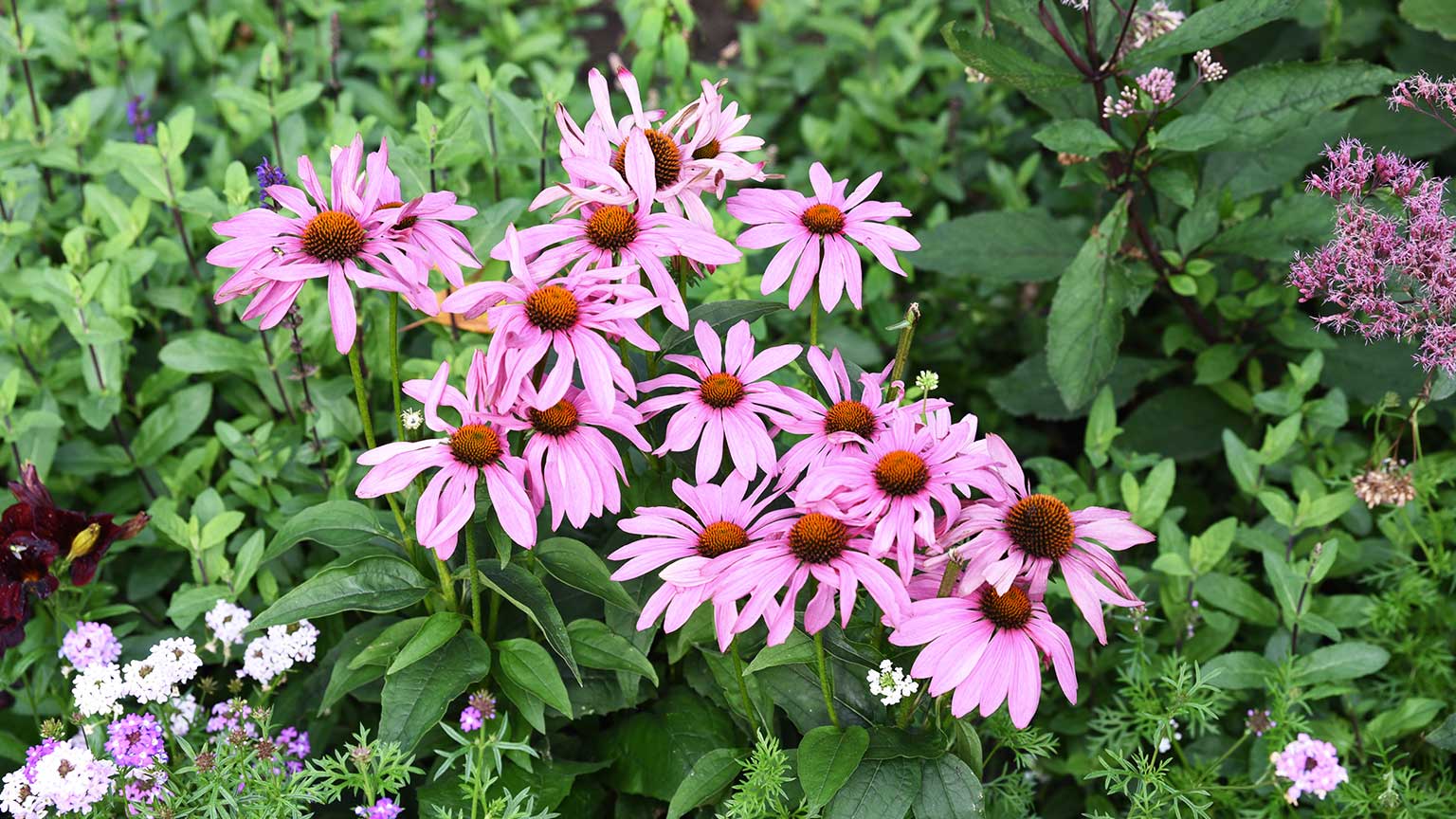
By mixing early- and late-blooming flower varieties, you can enjoy these colorful flowers for up to six months. Green Envy, Double Scoop Cranberry, Yellow My Darling, and Tennessee Purple are all bright, fun varieties.
Scientific name: Echinacea
Climate zone: Zones 3 to 9
How often to water: Every 7 days
5. Speedwells

Purple Illusion, Pink Potion, and White Wands are just a few of the most popular varieties that can brighten up your garden. These flowers have a tendency to attract beneficial insects and pollinators, which is a great way to help your backyard ecosystem thrive.
Scientific name: Veronica spicata
Climate zone: Zones 4 to 8
How often to water: Every 7 days
6. Delphinium

The height and color of the many varieties of this plant will stand out in any garden, especially Pacific Giant, which can grow up to 5 feet tall. You can expect light blue, mauve, purple, and white blooms in early to mid-summer.
Scientific name: Delphinium elatum
Climate zone: Zones 3 to 7
How often to water: Every 7 to 10 days
7. Pincushion Flower

These button-like flowers bloom from wiry stems and attract plenty of pollinators like bees and butterflies. You can’t go wrong with flowers like these.
Scientific name: Scabiosa
Climate zone: Zones 3 to 7
How often to water: Every 7 days
8. Texas Bluebell

Also known as Prairie Gentian, this flower is similar to a rose but comes in beautiful shades of blue, purple, pink, white, and even pale green. Some varieties are white with a darker shade of blue/purple toward the center of the bloom.
Scientific name: Lisianthus
Climate zone: Zones 8 to 10
How often to water: Every 7 to 10 days
9. Tickseed

The gorgeous, tiny yellow flowers of tickseed will add life to any garden. It’s also a super easy plant to care for since it thrives in poor-quality soil.
Scientific name: Coreopsis
Climate zone: Zones 4 to 10
How often to water: Every 7 to 10 days
10. Peony

Even though peonies have a short blooming season, their beauty and fragrance are well worth the effort. There are many varieties to choose between—including the Moutan peony, Chinese peony, and wild peony.
Scientific name: Paeonia
Climate zone: Zones 3 to 8
How often to water: Every 10 to 14 days
11. Goldenrod

These upright perennials are in the same family as sunflowers and have an enticing yellow color perfect for summertime. You’re bound to appreciate the vibrancy of these low-maintenance summer options.
Scientific name: Solidago
Climate zone: Zones 3 to 9
How often to water: Every 7 days
12. Snow in Summer

These delicate white flowers add an irresistible charm to any garden. They’ll likely look best when planted in a large plot of dirt where they can take up space, adding a whimsical feeling.
Scientific name: Cerastium tomentosum
Climate zone: Zones 3 to 7
How often to water: Every 5 to 7 days
13. Jupiter’s Beard
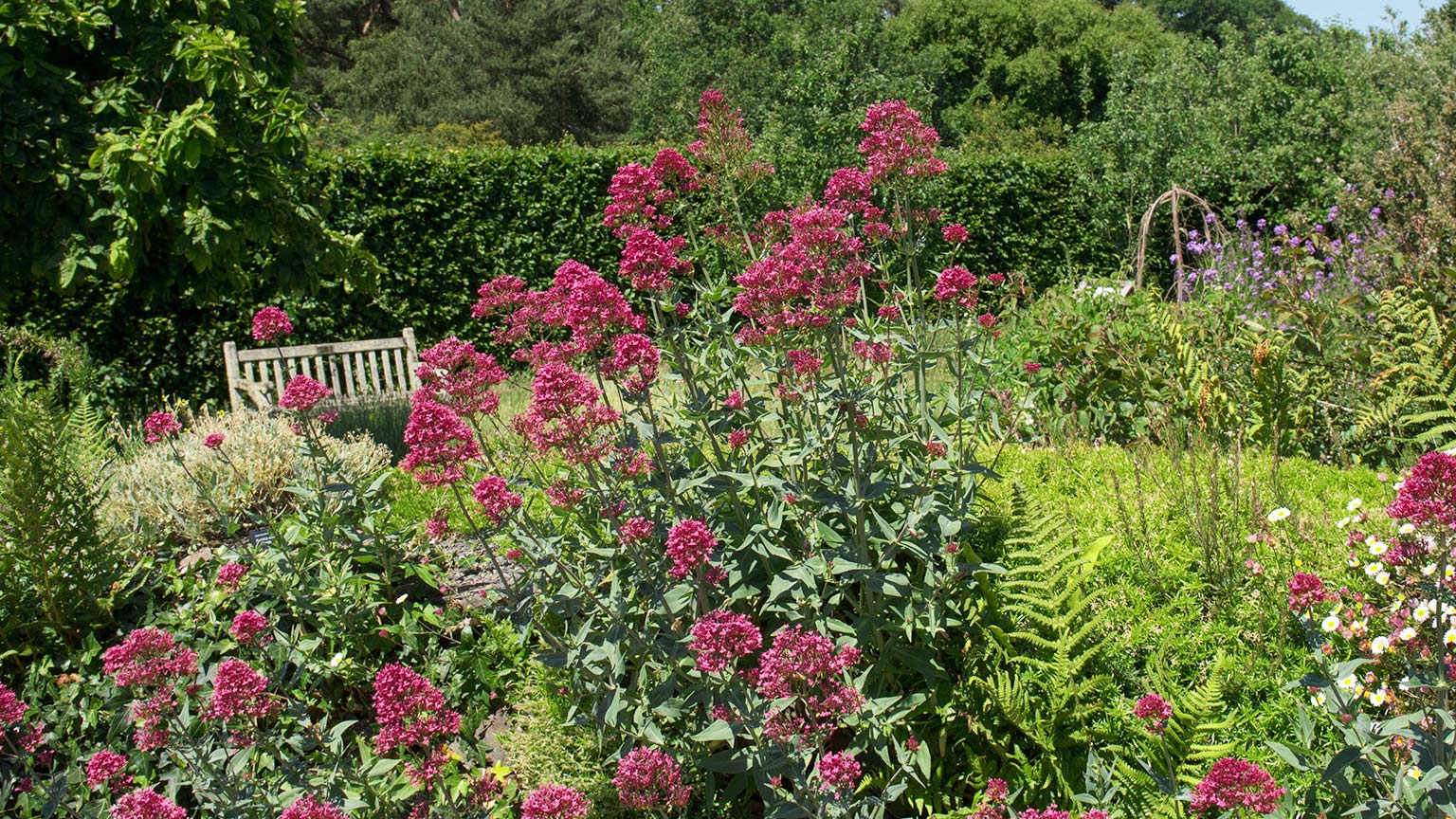
This durable wildflower has eye-catching clusters of tiny dark red flowers and thrives with minimal care. You’ll find yourself anxiously looking forward to this perennial every year.
Scientific name: Centranthus ruber
Climate zone: Zone 4 to 9
How often to water: Every 7 to 10 days
14. Sweet William

This fragrant flower has a stunning blossom that is sure to become a highlight of your garden.
Scientific name: Dianthus barbatus
Climate zone: Zones 3 to 8
How often to water: Every 7 to 10 days
15. Monkshood

Naturally found growing in mountain meadows, this dainty wildflower’s purple petals will add a fun splash of color.
Scientific name: Aconitum napellus
Climate zone: Zones 3 to 7
How often to water: Every 7 days
16. Iris

One of the most popular flowers because of its unique petals and rich hues, the iris is also conveniently deer-resistant. Whether you prefer a pink-violet shade or a crisp white with deep purple accents, you’ll be pleased to see this flower appear year after year.
Scientific name: Iris germanica or siberica
Climate zone: Zones 2 to 10
How often to water: Every 7 to 10 days
17. Salvia

Whether it’s blue or red salvia, you really can’t go wrong when you group multiple plants together to create a colorful cluster. These plants thrive in full sun and well-drained soil, too.
Scientific name: Salvia officinalis
Climate zone: Zones 5 to 10
How often to water: Every 5 to 7 days
Partial Sun Perennials for Summer
Below, you’ll find shade-loving perennials that benefit from just about four hours or fewer of sunlight a day. These ideas are especially great if you're working with a shaded backyard or a small patio.
18. Hosta

There are hundreds of hostas in different sizes and leaf structures. The Coast to Coast and Empires Wu hostas are super hearty.
Scientific name: Hosta spp.
Climate zone: Zones 3 to 9
How often to water: Every 7 to 10 days
19. Blue Wave

This flower, which is reminiscent of a lily, has a captivating color and works well alongside multiple plant species. Plus, it’s animal-resistant, so you won’t have to worry about local wildlife taking a bite out of the blooms.
Scientific name: Agapanthus
Climate zone: Zones 6 to 11
How often to water: Every 5 to 7 days
20. Hardy Geranium

The two main varieties of geraniums you can choose from include Ann Folkard and Johnson’s Blue. Both have a striking appearance that will stand out from other flowers in your garden.
Scientific name: Geranium magnificum
Climate zone: Zones 4 to 9
How often to water: Every 7 to 10 days
21. Foxglove

The unique shape of this flower species is sure to be a highlight of your summer garden. Camelot Mix foxglove is one of the most beautiful varieties.
Scientific name: Digitalis
Climate zone: Zones 4 to 10
How often to water: Every 7 days
22. Japanese Anemone

Like most anemone flowers, the Japanese anemone performs best in evenly-moist, well-drained soil. You’ll find yourself captivated by the dainty yet bold presence of these bright pink blooms.
Scientific name: Anemone hupehensis
Climate zone: Zones 3 to 8
How often to water: Every 7 days
23. Beardtongue

Thriving in hot, sunny environments, these wildflowers grow and bloom quickly when planted. Whether you like a deep, saturated magenta or a pale lavender, you have a wide variety of colors to choose between.
Scientific name: Penstemon
Climate zone: Zones 3 to 8
How often to water: Every 5 to 7 days
24. Lady’s Mantle

The appealing gray-green foliage of this flower, with its partially round scalloped edges, makes it a summer garden staple.
Scientific name: Alchemilla mollis
Climate zone: Zones 3 to 7
How often to water: Every 7 days
25. Gomphrena

If you’re looking for a round, visually dominant flower in a wide range of bright, saturated shades, look no further. Keep an eye out for colors like magenta, purple, red, orange, white, pink, and lilac.
Scientific name: Gomphrena globosa
Climate zone: Zones 7 to 10
How often to water: Every 7 days
26. Hydrangea

The clusters of small flowers surrounded by a ring of more prominent flowers make the hydrangea one of a kind. Colors range from white and magenta to sky blue and violet.
Scientific name: Hydrangea macrophylla
Climate zone: Zones 3 to 9
How often to water: Every 7 to 10 days
27. Bleeding Heart

This flower’s dainty petals truly do resemble a heart and dangle beautifully from lush green stems. These are a popular choice for any yard because they add a pop of memorable color and are a great conversation piece.
Scientific name: Lamprocapnos
Climate zone: Zones 3 to 9
How often to water: Every 7 days
28. Tiger Lily

The striking orange hue and unique shape of the tiger lily will make it stand out from others in your garden. These are commonly planted in front yards to boost curb appeal with their eye-catching color.
Scientific name: Lilium lancifolium
Climate zone: Zones 3 to 9
How often to water: Every 7 days
Full Sun Annuals for Summer
Below, you’ll find sun-loving annuals that thrive when exposed to direct sunlight the majority of the day.
29. Verbena

With over 150 different species, verbena is a square-stemmed creeping plant with beautiful, small flowers that bloom from July to September.
Scientific name: Verbena officinalis
Climate zone: Zones 7 to 11
How often to water: Every 7 to 10 days
30. Summer Snapdragon

This upright plant is a tropical bush with a long blooming period of its alluring flowers. The curl of the petals is different from any other flower, and the vibrant colors are unforgettable.
Scientific name: Angelonia angustifolia
Climate zone: Zones 9 to 11
How often to water: Every 7 days
31. Lantana

This flower species is a part of the verbena family and thrives in extremely hot climates since it’s native to tropical America and Africa. You’ll want to plant these in your front yard to show them off.
Scientific name: Lantana camara
Climate zone: Zones 7 to 11
How often to water: Every 7 to 10 days
32. Million Bells

This compact plant produces flowers that resemble small petunias and come in a variety of colors. You’ll likely want to plant these in a pot and keep a close eye on soil moisture to make sure you aren’t overwatering or neglecting them.
Scientific name: Calibrachoa
Climate zone: Zones 2 to 10
How often to water: Every 7 days
33. Dahlia

In the same family as sunflowers, daisies, and zinnia, the dahlia is one of the most dazzling garden flowers, especially in a rich red or magenta color. The layered petals on the flower make it a summer favorite.
Scientific name: Dahlia pinnata
Climate zone: Zones 3 to 7
How often to water: Every 7 days
34. Sweet Alyssum

Not only do these flowers have a pleasant aroma, but they also provide small, tasteful blooms that make a great addition to a bouquet.
Scientific name: Lobularia maritima
Climate zone: Zones 7 to 11
How often to water: Every 5 to 7 days
35. Begonia

Annual begonia care is pretty simple—the main thing you need to do is make sure the soil stays moist. Begonias look especially beautiful when planted in clusters.
Scientific name: Begonia x semperflorens-cultorum
Climate zone: Zones 3 to 9
How often to water: Every 5 to 7 days
36. Pentas

These interesting flowers feature fuzzy green leaves and clusters of red, white, pink, and purple blooms. You’re bound to fall in love with the tiny five-pronged petals.
Scientific name: Pentas lanceolata
Climate zone: Zones 9 to 11
How often to water: Every 7 days
37. Ageratum

Ageratum flowers bloom from spring until fall with the right care and attention. The breathtaking periwinkle color of the petals is enough for anyone to want to replant them year after year.
Scientific name: Ageratum houstonianum
Climate zone: Zones 3 to 7
How often to water: Every 7 to 10 days
38. Zinnia

Zinnias are resilient in many conditions, but ideally, they’re planted in rich, well-drained soil. Be sure to try deadheading, or removing dead flowers from plants, to allow the plant to bloom more frequently.
Scientific name: Zinnia elegans
Climate zone: Zones 2 to 11
How often to water: Every 7 days
39. Sunflower
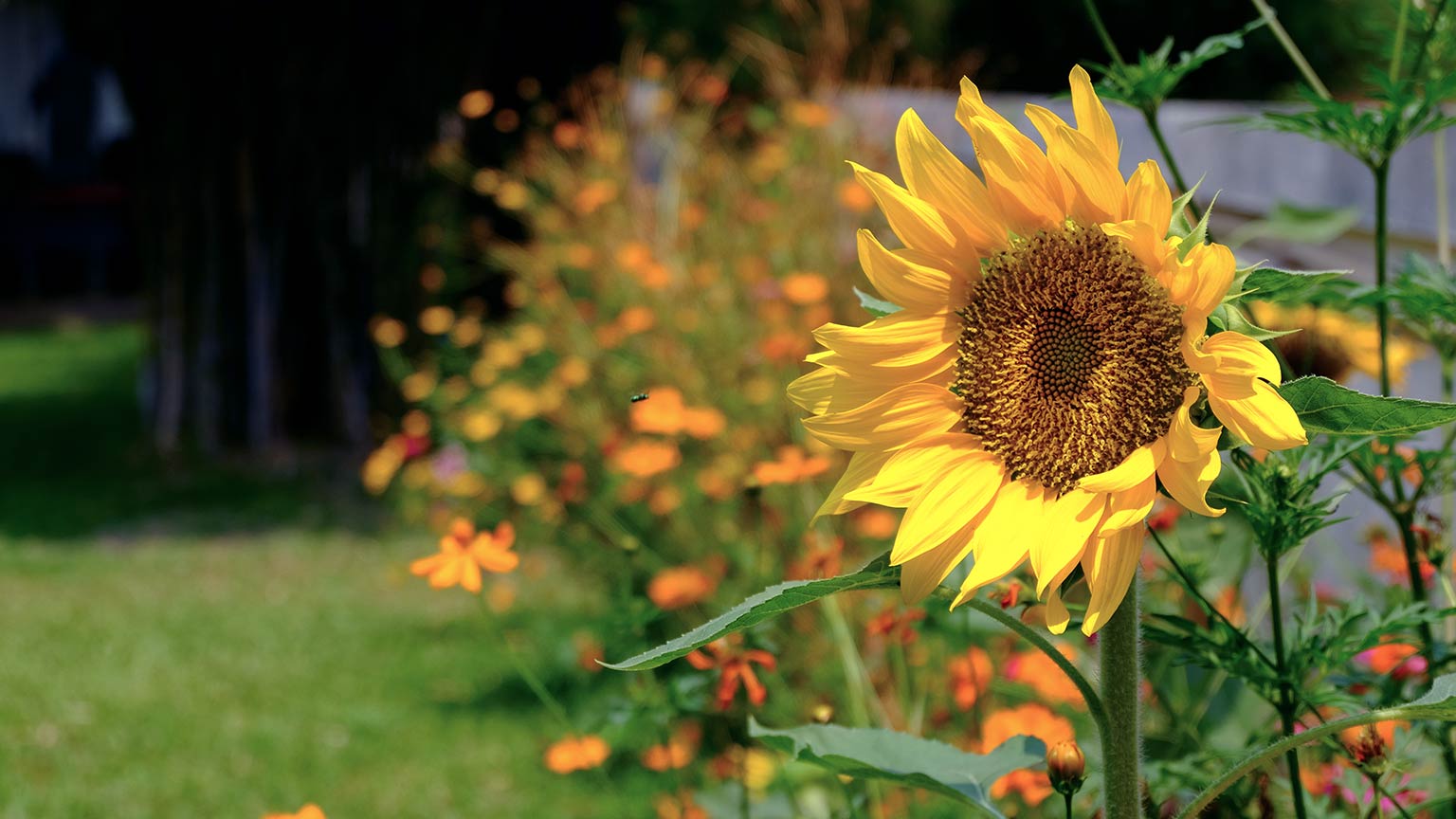
Sunflowers just scream summer. They often grow up to 8 feet tall, depending on the variety and their soil and water conditions.
Scientific name: Helianthus annuus
Climate zone: Zones 4 to 9
How often to water: Every 7 to 10 days
Partial Sun Annuals for Summer
The annual flowers below benefit from about four hours of sunlight exposure per day but don’t do well under relentless heat.
40. African Marigold

Marigolds have pom-pom-like blooms in bright colors such as orange, so they’re sure to be a bold addition to any summer garden.
Scientific name: Tagetes erecta
Climate zone: Zones 2 to 11
How often to water: Every 5 to 7 days
41. Pansy

Pansies are in their prime in late spring/early summer. Their eye-catching color patterns make them perfect for adding curb appeal.
Scientific name: Viola tricolor
Climate zone: Zones 6 to 11
How often to water: Every 7 days
42. Gerbera Daisy

These bright yellow flowers love the sun but need a break from the direct heat. They also thrive when they are 12 to 18 inches apart—this gives them some breathing room.
Scientific name: Gerbera jamesonii
Climate zone: Zones 8 to 11
How often to water: Every 7 days
43. Fuchsia

The characteristic color of these flowering shrubs will stand out from the rest of your summer garden. Be sure to plant them in well-draining soil.
Scientific name: Fuchsia magellanica
Climate zone: Zones 6 to 7
How often to water: Every 7 days
44. Impatiens

These small, extremely colorful annuals are sure to add streaks of color to your summer flower bed. These flowers are planted as annuals in most regions except tropical, warm regions.
Scientific name: Impatiens walleriana
Climate zone: Zones 2 to 11
How often to water: Every 5 to 7 days
45. Cosmos

This small-to-medium-sized flower is a part of the daisy family. White, yellow, lavender, magenta, and orange are all common color varieties that pop in any summer garden.
Scientific name: Cosmos bipinnatus
Climate zone: Zones 2 to 11
How often to water: Every 5 to 7 days
46. Periwinkle
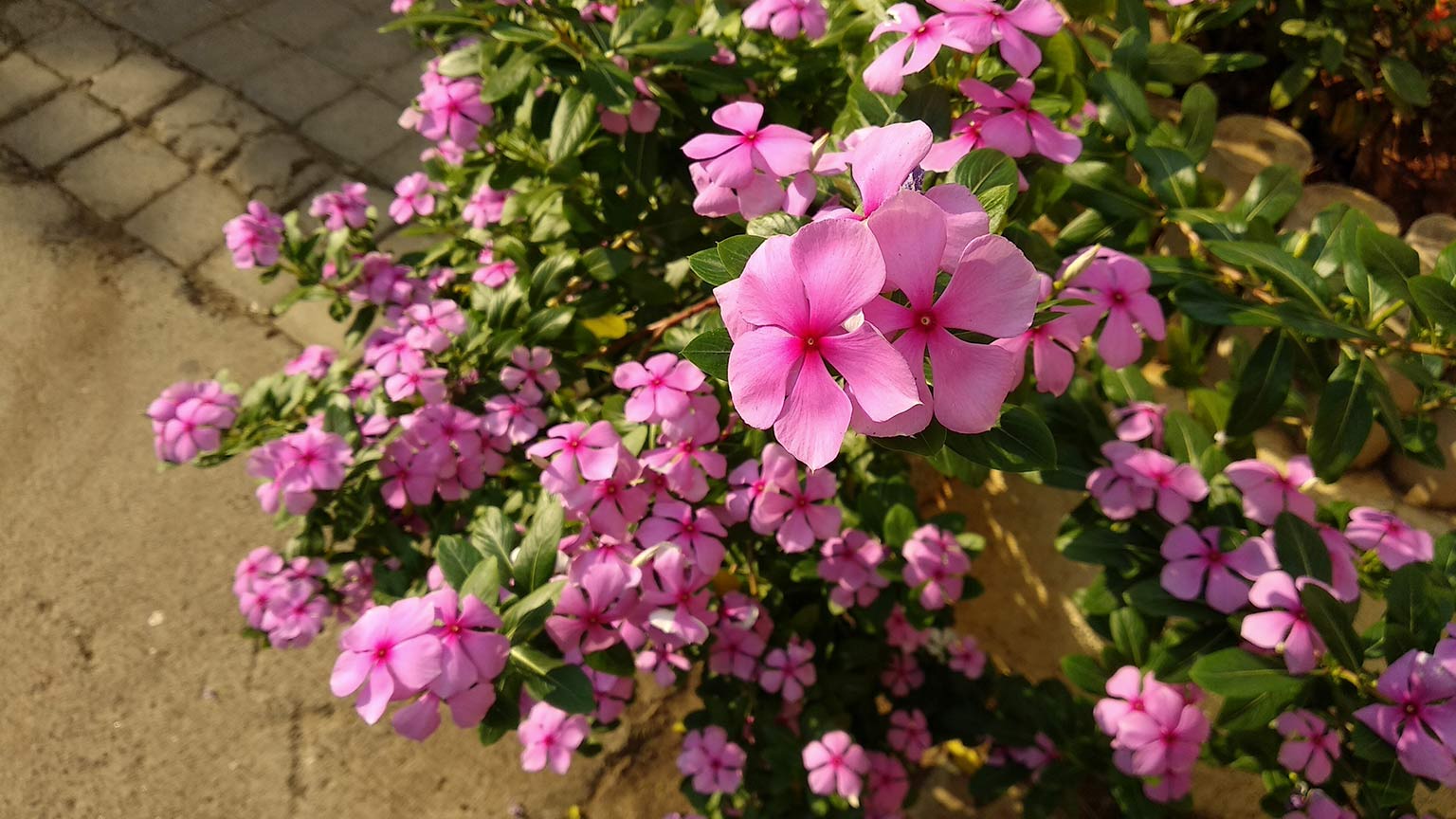
These hardy, low-maintenance light blue-lavender flowering plants are conveniently pest-resistant.
Scientific name: Vinca minor
Climate zone: Zones 7 to 9
How often to water: Every 7 days
47. Mexican Sunflower

If you’re a fan of bright, saturated yellows and oranges, you won’t be able to resist the daisy-like blooms of the Mexican sunflower.
Scientific name: Tithonia rotundifolia
Climate zone: Zones 9 to 11
How often to water: Every 7 to 10 days
48. Four O’Clocks

Also known as “Marvel of Peru” plants, four o'clocks march to the beat of their own drum and don’t open until late in the day. They are most frequently bright purple, pink, or red.
Scientific name: Mirabilis jalapa
Climate zone: Zones 7 to 10
How often to water: Every 7 days
49. Sea Holly
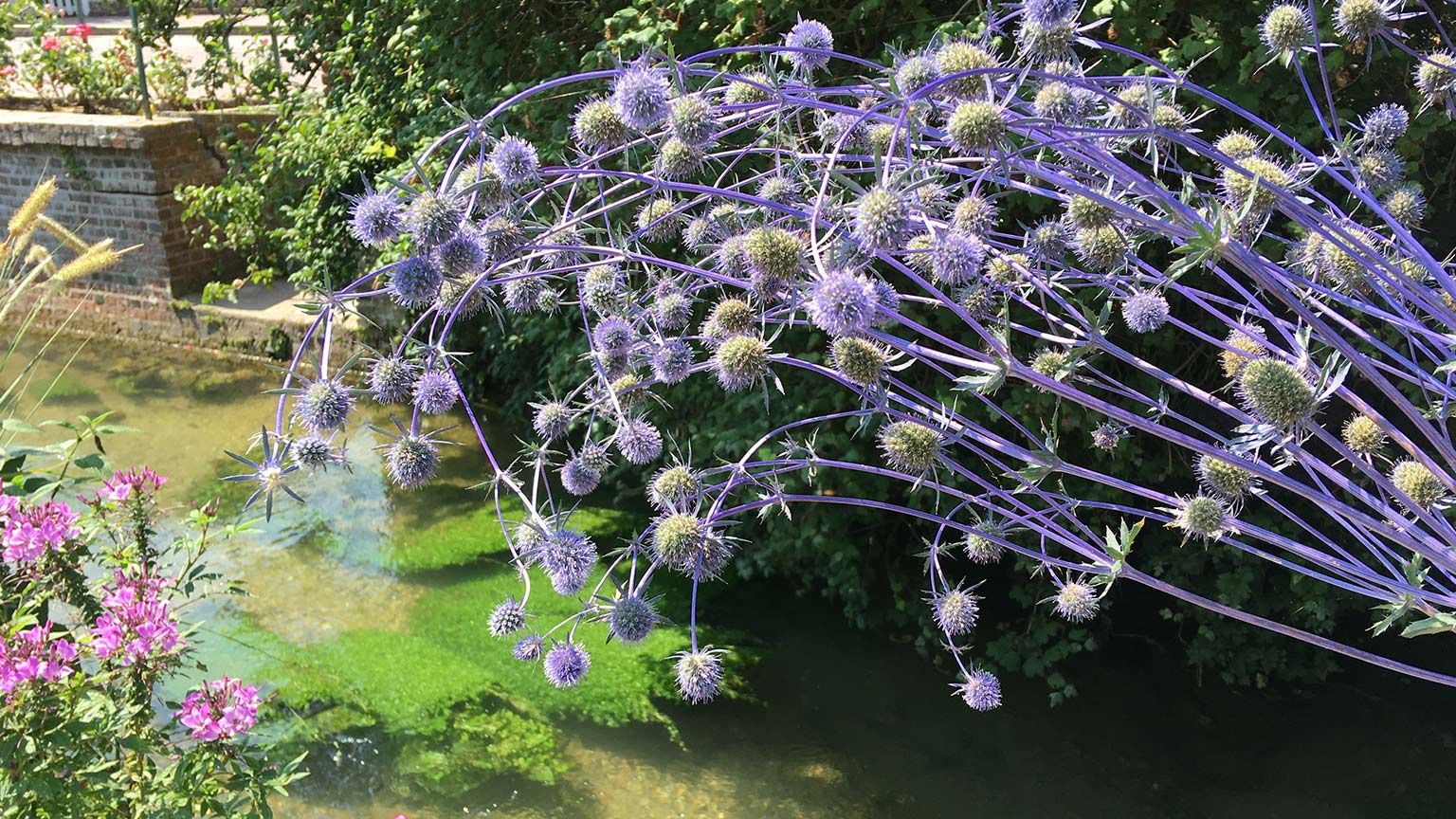
This summer flower features steel-blue, thistle-like blooms on branched stems. Sea holly is a great choice as the foundation of a flower bed with other similarly colored larger flowers in the forefront.
Scientific name: Eryngium
Climate zone: Zones 4 to 9
How often to water: Every 7 days
50. Rose of Sharon

These small flowering shrubs have an almost tropical look with multicolored petals that are usually variations of white, red, and pink.
Scientific name: Hibiscus syriacus
Climate zone: Zones 5 to 9
How often to water: Every 7 to 10 days
51. Queen of the Prairie

This gorgeous flower’s bloom resembles a pink cloud or a handful of cotton candy. These clusters of flowers can blend nicely with a wide variety of other colorful flowers, too.
Scientific name: Filipendula rubra
Climate zone: Zones 3 to 6
How often to water: Every 7 to 10 days
52. Poppy

Poppies are lovely additions to any summer garden, thanks to their signature red-orange hue. They tend to grow well in almost any type of well-drained soil.
Scientific name: Papaver rhoeas
Climate zone: Zones 3 to 8
How often to water: Every 7 days
53. Gaillardia

These small flowers are drought-tolerant and showcase a radiant blend of colors on their petals.
Scientific name: Gaillardia aristata
Climate zone: Zones 4 to 8
How often to water: Every 7 to 10 days
Summer Flowers Guide Infographic
The examples above are by no means an exhaustive list of flowers, but we hope they at least served as food for thought as you start your summer gardening journey. You might even consider hiring a landscaper who is well-versed in various flower species and how they interact and grow in different regions.
As you brainstorm ideas for the quintessential summer flower bed, enjoy the infographic below with the top highlights from the flower gardening guide above.






- Landscapers
- Tree Surgeons
- Gardening Services
- Landscape Architects
- Sod Installation
- Tennis Court Contractors
- Landscape Design
- Retaining Wall Companies
- Grading Companies
- Landscape Rock & Sand Delivery
- Mulch Delivery Services
- Pond Companies
- Artificial Grass Companies
- Shrub Removal & Trimming
- Backyard Design Companies
- Commercial Landscaping
- Koi Pond Services
- Backyard Landscapers
- Trampoline Assembly
- Hedge Trimming
- Pond Services
- Garden Design
- Outdoor Plant Watering
- Putting Greens
- French Drains
- Turf Installation
- Sod Removal Services
- Lawn Repair Services
- Brush Chipping Services
- Hardscape Contractor
- Landscape Rock Removal
- 16 of the Best Perennials to Plant for Year-Round Color
- Flowers That Will Add Color to Your Garden Throughout the Year
- The Top 20 New Plants Hitting the Market in 2024
- 11 Fall Flowers to Plant for a Beautiful Garden
- 14 Unique Plants to Make Your Garden the Talk of the Town
- 27 Creative and Beautiful Flower Bed Ideas
- 47 Landscaping Ideas to Consider for Your Home
- Fresh Flowers Looking Fatigued? Prolong Their Life With These 7 Tips
- The 8 Best Native Bulbs to Plant in the Midwest for Spring
- 13 Lawn Alternatives for a Low-Maintenance Yard









